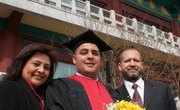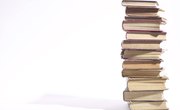When the Greeks identified the seven "liberal arts" (which today encompass many more than seven disciplines), little did they imagine the confusion they were creating for future college students. Many of the schools you are considering might boast that they offer a "broad, liberal arts education," while others offer a "liberal studies" major. To understand the difference, it helps to first understand what the Greeks considered "liberal arts," and why a "liberal" education is valuable in modern society.
Greek Origins of "Liberal Arts"
The ancient Greeks identified seven "artes liberales," areas of study which they considered to be important for all educated citizens to know: the "trivium," or three lesser disciplines (studied first) were grammar, logic and rhetoric; students then went on to the "quadrivium" of arithmetic, geometry, astronomy and music. The Greeks therefore founded the principle that people in an educated society should have exposure to a broad range of studies including communication, math, science and arts, and that all these studies should have an underpinning of logic and critical thinking.
Modern Liberal Arts and Liberal Arts Colleges
The "liberal arts" continue to refer to disciplines in the humanities (such as visual and performing arts, writing and literary analysis); social sciences (such as history, sociology and anthropology); sciences (such as biology, chemistry, physics and astronomy) and mathematics.
The term "liberal arts" usually refers to a type of college that requires students to take courses in all these disciplines and stresses breadth of knowledge, critical thinking skills and multiple approaches to problem-solving over depth of knowledge in one particular area--though most liberal arts colleges also require students to choose a "major" discipline in which to take several courses and achieve some depth.
Alternatives to Liberal Arts
The United States is one of the few countries in the world where liberal arts colleges are common. Most universities worldwide have high-school graduates apply to specific departments, and college students take courses only (or mostly) in their one chosen field.
In the United States, too, many institutions of higher learning offer a "pre-professional" or "trade" education, training students to perform specific, practical jobs rather than requiring them to, say, learn foreign languages or demonstrate understanding of history or arts.
Liberal Studies
"Liberal Studies" usually refers to a specific major open to undergraduate students and sometimes to Master's students as well. It is an interdisciplinary major, requiring coursework in a range of the liberal arts, and often also requires special courses in which students analyze the relationships between the different Liberal disciplines.
Liberal Studies Degrees
The Liberal Studies major is often offered at two-year colleges, where most students are working toward an Associate Degree in a pre-professional area. Those students who plan to transfer to four-year liberal arts colleges often major in Liberal Studies so that their transfer credits will fullfill the "breadth" requirements at their new school.
Some four-year colleges offer Liberal Studies majors as well, especially schools with an "open curriculum," where students are encouraged to create their own course of study. A student who earns a B.A. in Liberal Studies (as opposed to, say, a B.A. in physics or psychology or art history) has demonstrated an interest in exposing himself to as wide a variety of disciplines as possible and learning as much as he can about the world and the ways people experience it.
Master's programs in Liberal Studies, too, typically have more flexible programs and allow students to approach their interests in a multidisciplinary way.
Related Articles
References
Writer Bio
Sarah Bronson received her Master of Arts in journalism from New York University in 2002. Since then her clients have included "The New York Times," "Glamour," "Executive Travel," "Fodor's," "The Jerusalem Report," "ESPN—The Magazine," the "Washington Times" and "Figure" magazine. Her areas of expertise include biotechnology, health, education, travel, Judaism and fashion.










